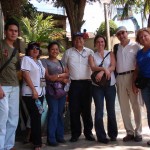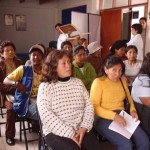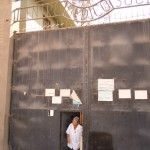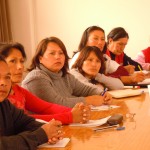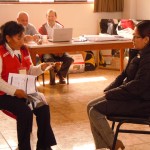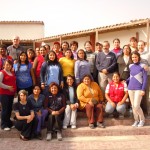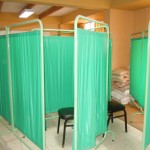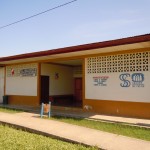The Peru Cervical Cancer Prevention Study
PERCAPS was a 2 Phase pilot project funded through the Merck Investigator Initiated Studies Program. It represented the first project for POI in our new community based screening initiative. After years of technology based studies, we believed the important elements of screening technologies were solved. Of course more progress will be made but the big problem was that no one had figured out how to get the technology that now exists to the people who need access the most.
PERCAPS was a community based project that explored the utility of Community Based Participatory Research techniques in a mother-child screen/ treat and vaccinate program for cervical cancer prevention first in Manchay, Peru and then in the low Amazon jungle (Iquitos and surrounding villages).
Methods/ materials: HPV self-sampling and cryotherapy were utilized for the screen/treat intervention, and the Gardasil vaccine was utilized for the vaccine intervention. Community health workers from Manchay and Iquitos participated in an educational course developed and modified by the research team. The community health workers then decided how to implement the interventions in their community. The success of the program was measured by: 1) the ability of the community health workers to determine an implementation plan, 2) the successful use of research forms provided, 3) participation and retention rates, and 4) satisfaction of the participants. In addition the new technologies applied to the screening were also evaluated for their adaptability to large scale screening programs.
Conclusion: Community Based Participatory Research techniques successfully helped to implement a screen/treat and vaccinate cervical cancer prevention program in Manchay and Iquitos Peru. These techniques may help overcome barriers to large-scale preventive health-care interventions.
This work has produced 3 manuscripts and lead to the Chinese Cervical Cancer Prevention Study (CHICAPS), which is currently ongoing. (see references Levinson K and Abuelo C)
(see CHICAPS)
Photos
Please click on any image to zoom, then use < > or arrow keys to navigate.
REFERENCES
1. Int J Gynecol Cancer. 2013 Jan;23(1):141-7. doi: 10.1097/IGC.0b013e318275b007.
The Peru cervical cancer prevention study (PERCAPS): community-based participatory research in Manchay, Peru.
Levinson KL(1), Abuelo C, Chyung E, Salmeron J, Belinson SE, Sologuren CV, Ortiz
CS, Vallejos MJ, Belinson JL.
Author information:
(1)The Cleveland Clinic, Department of Obstetrics and Gynecology, Division of
Gynecologic Oncology, Cleveland, OH, USA. levinsk@ccf.org
OBJECTIVE: Cervical cancer is a preventable disease which causes significant
morbidity and mortality, particularly in developing countries. Although
technology for early detection continues to improve, prevention programs suffer
from significant barriers. Community-based participatory research is an approach
to research which focuses on collaboration with the community to surmount these
barriers. The objective of this study was to evaluate the utility of
community-based participatory research techniques in a mother-child screen/treat
and vaccinate program for cervical cancer prevention in Manchay, Peru.
MATERIALS AND METHODS: Human papillomavirus (HPV) self-sampling and cryotherapy
were used for the screen/treat intervention, and the Gardasil vaccine was used
for the vaccine intervention. Community health workers from Manchay participated
in a 3-day educational course, designed by the research team. The community
health workers then decided how to implement the interventions in their
community. The success of the program was measured by (1) the ability of the
community health workers to determine an implementation plan, (2) the successful
use of research forms provided, (3) participation and retention rates, and (4)
satisfaction of the participants.
RESULTS: (1) The community health workers used a door-to-door approach through
which participants were successfully registered and both interventions were
successfully carried out; (2) registration forms, consent forms, and result
forms were used correctly with minimal error; (3) screen/treat intervention: 97%
of registered participants gave an HPV sample, 94% of HPV-positive women were
treated, and 90% returned for 6-month follow-up; vaccine intervention: 95% of
registered girls received the first vaccine, 97% of those received the second
vaccine, and 93% the third; (4) 96% of participants in the screen/treat
intervention reported high satisfaction.
CONCLUSIONS: Community-based participatory research techniques successfully
helped to implement a screen/treat and vaccinate cervical cancer prevention
program in Manchay, Peru. These techniques may help overcome barriers to
large-scale preventive health-care interventions.
DOI: 10.1097/IGC.0b013e318275b007
PMCID: PMC3529758
PMID: 23165314 [Indexed for MEDLINE]
2. Gynecol Oncol. 2013 May;129(2):318-23. doi: 10.1016/j.ygyno.2013.01.026. Epub
2013 Feb 4.
The Peru Cervical Cancer Prevention Study (PERCAPS): the technology to make screening accessible.
Levinson KL(1), Abuelo C, Salmeron J, Chyung E, Zou J, Belinson SE, Wang G,
Ortiz CS, Vallejos CS, Belinson JL.
Author information:
(1)The Cleveland Clinic, 9500 Euclid Ave, Cleveland, OH 44195, USA.
kimlynnlev@gmail.com
OBJECTIVE: This study utilized a combination of HPV self-sampling, iFTA elute
specimen cards, and long distance transport for centralized processing of
specimens to determine the feasibility of large-scale screening in remote and
transient populations.
METHODS: This study was performed in two locations in Peru (Manchay and
Iquitos). The “Just For Me” cervico-vaginal brush and iFTA elute cards were used
for the collection and transport of specimens. Samples were shipped via FedEx to
China and tested for 14 types of high-risk HPV using PCR based MALDI-TOF. HPV
positive women were treated with cryotherapy after VIA triage, and followed-up
with colposcopy, biopsy, ECC, and repeat HPV testing at 6 months.
RESULTS: Six hundred and forty three women registered, and 632 returned a sample
over a 10 day period. Within 2 weeks, specimens were shipped, samples tested,
and results received by study staff. Sixty-eight women (10.8%) tested positive,
and these results were delivered over 4 days. Fifty-nine HPV positive women
(87%) returned for evaluation and treatment, and 2 had large lesions not
suitable for cryotherapy. At 6 months, 42 women (74%) returned for follow-up,
and 3 had CIN 2 (all positive samples from the endocervical canal). Ninety eight
percent of participants reported that they would participate in this type of
program again.
CONCLUSIONS: Utilizing HPV self-sampling, solid media specimen cards for long
distance transport, and centralized high throughput processing, we achieved
rapid delivery of results, high satisfaction levels, and low loss to follow-up
for cervical cancer screening in remote and transient populations.
Copyright © 2013 Elsevier Inc. All rights reserved.
DOI: 10.1016/j.ygyno.2013.01.026
PMCID: PMC3632388
PMID: 23385153 [Indexed for MEDLINE]
Conflict of interest statement: Conflict of Interest Statement: Preventive
Oncology International has received support in kind (reagents and testing)
and/or funds for direct support and research from Hologic Inc., Qiagen,
Gen-Probe, Merck Inc., BGI Shenzhen, and GE Healthcare.
3. J Community Health. 2014 Jun;39(3):409-15. doi: 10.1007/s10900-013-9786-6.
The Peru Cervical Cancer Screening Study (PERCAPS): the design and
implementation of a mother/daughter screen, treat, and vaccinate program in the Peruvian jungle.
Abuelo CE(1), Levinson KL, Salmeron J, Sologuren CV, Fernandez MJ, Belinson JL.
Author information:
(1)Charlestown HealthCare Center, Massachusetts General Hospital, 73 High St,
Charlestown, MA, 02445, USA, cabuelo@partners.org.
Peru struggles to prevent cervical cancer (CC). In the jungle, prevention
programs suffer from significant barriers although technology exists to detect
CC precursors. This study used community based participatory research (CBPR)
methods to overcome barriers. The objective was to evaluate the utility of CBPR
techniques in a mother-child screen/treat and vaccinate program for CC
prevention in the Peruvian jungle. The CC prevention program used self-sampling
for human papillomavirus (HPV) for screening, cryotherapy for treatment and the
HPV vaccine Gardasil for vaccination. Community health leaders (HL) from around
Iquitos participated in a two half day educational course. The HLs then decided
how to implement interventions in their villages or urban sectors. The success
of the program was measured by: (1) ability of the HLs to determine an
implementation plan, (2) proper use of research forms, (3) participation and
retention rates, and (4) participants’ satisfaction. HLs successfully registered
320 women at soup kitchens, schools, and health posts. Screening, treatment, and
vaccination were successfully carried out using forms for registration, consent,
and results with minimum error. In the screen/treat intervention 100% of
participants gave an HPV sample and 99.7% reported high satisfaction; 81% of HPV
+ women were treated, and 57% returned for 6-month followup. Vaccine
intervention: 98% of girls received the 1st vaccine, 88% of those received the
2nd, and 65% the 3rd. CBPR techniques successfully helped implement a
screen/treat and vaccinate CC prevention program around Iquitos, Peru. These
techniques may be appropriate for large-scale preventive health-care
interventions.
DOI: 10.1007/s10900-013-9786-6
PMCID: PMC4543313
PMID: 24276617 [Indexed for MEDLINE]



